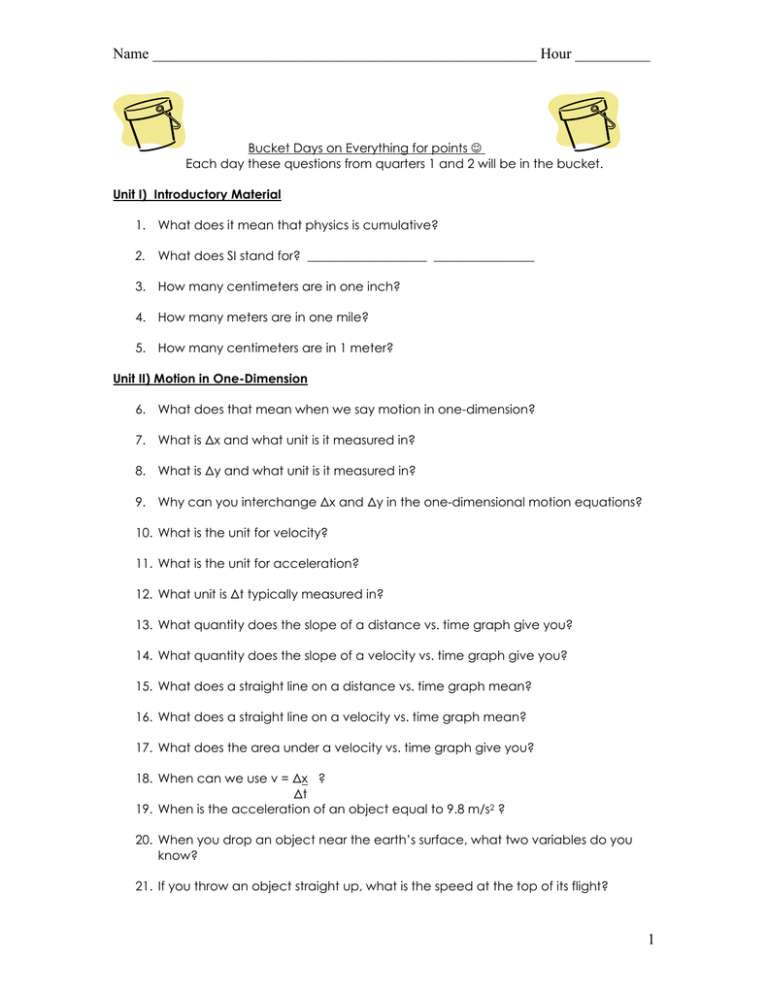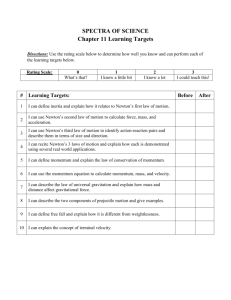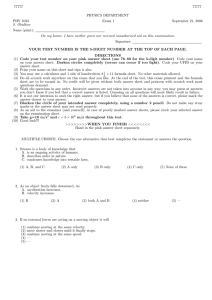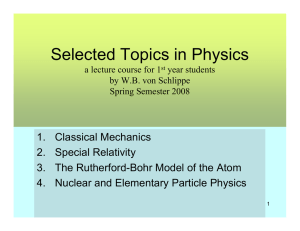Name ___________________________________________________ Hour __________
advertisement

Name ___________________________________________________ Hour __________ Bucket Days on Everything for points Each day these questions from quarters 1 and 2 will be in the bucket. Unit I) Introductory Material 1. What does it mean that physics is cumulative? 2. What does SI stand for? ___________________ ________________ 3. How many centimeters are in one inch? 4. How many meters are in one mile? 5. How many centimeters are in 1 meter? Unit II) Motion in One-Dimension 6. What does that mean when we say motion in one-dimension? 7. What is Δx and what unit is it measured in? 8. What is Δy and what unit is it measured in? 9. Why can you interchange Δx and Δy in the one-dimensional motion equations? 10. What is the unit for velocity? 11. What is the unit for acceleration? 12. What unit is Δt typically measured in? 13. What quantity does the slope of a distance vs. time graph give you? 14. What quantity does the slope of a velocity vs. time graph give you? 15. What does a straight line on a distance vs. time graph mean? 16. What does a straight line on a velocity vs. time graph mean? 17. What does the area under a velocity vs. time graph give you? 18. When can we use v = Δx ? Δt 19. When is the acceleration of an object equal to 9.8 m/s2 ? 20. When you drop an object near the earth’s surface, what two variables do you know? 21. If you throw an object straight up, what is the speed at the top of its flight? 1 Name ___________________________________________________ Hour __________ 22. If you throw an object up and it takes 4 seconds to reach the top, how long is it in the air? 23. If you throw an object straight up and it is in the air for 3 seconds, how long did it take to reach the top of its flight? Unit III : Vectors 24. What is a scalar? 25. What is a vector? 26. Give an example of a quantity that is a scalar. 27. Give an example of a quantity that is a vector. 28. What is the sum of two or more vectors called? Unit IV : Projectile Motion 29. What does ay equal? 30. What is vx ? 31. What is viy? 32. Why can’t you interchange Δx and Δy when solving two-dimensional motion problems? 33. If you drop a bullet and shoot a bullet horizontally from the same height, which one will hit first in a vacuum where there is no air resistance? 34. If you drop a bullet and shoot a bullet horizontally from the same height, which one will hit first when there is air resistance? 35. If an object is shot horizontally, what does viy equal? 36. What is a projectile? 37. Give an example of a projectile. 38. What Greek letter do we use to represent an angle? 39. If a projectile is fired at an angle with velocity v, which trig function can we use to find vx ? 40. What happens to the velocity of a projectile in the x direction throughout its flight and why? 41. What happens to the velocity of a projectile in the y direction throughout its flight and why? 2 Name ___________________________________________________ Hour __________ 42. What is vfy ? 43. Why can’t we use ay = (vfy – viy) / Δt when we shoot a projectile horizontally? Unit V: Newton’s Laws and Forces 44. What is a force? 45. What unit do we typically use to measure force? 46. What is Newton’s 1st Law? 47. What is Newton’s 2nd Law? 48. What is Newton’s 3rd Law? 49. What exactly is a Newton? (not just a unit of force - actual definition) 50. Which one of Newton’s Laws says that for every action there is an equal and opposite reaction? 51. Which one of Newton’s Laws says F=ma? 52. Which one of Newton’s Laws is this? a. An object at rest remains at rest and an object in motion remains in motion unless acted upon by an outside force? 53. What is inertia? 54. When jumping out of a plane with a parachute, what two forces are acting on you? 55. What is the mathematical relationship between vector F, Fx and Fy ? 56. What is one of the two cases when equilibrium can occur? 57. If an object is in equilibrium, what is the sum of all of the forces acting on it? 58. A 400-N woman sits on the floor. What force does the floor exert on her? 59. Which has more mass, a kilogram of feathers or a kilogram of iron? 60. What is mass and what unit is it in? 61. What is weight and what unit do we measure it in? 62. What quantity do you get if you divide weight by mass? 63. What unit do you get when you divide force by acceleration? 64. What is terminal velocity? 3 Name ___________________________________________________ Hour __________ 65. What is the acceleration of an object equal to when it reaches terminal velocity? 66. What is a g force? 67. If you know your mass in kilograms, how could you find out what one g force is for you in Newtons? 68. How do you find the number of g’s? (equation) Unit VI: Work and Energy 69. What is the unit for work? 70. How many Watts are in a kilowatt? 71. How many Watts are in one horsepower? 72. What is one of the three units we use for power? 73. What unit for power will come out in the equation P = W / Δt? 74. What is the definition for potential energy (P.E.)? 75. What is the definition for kinetic energy (K.E.)? 76. What is the kinetic energy of a cat that is sitting still and is 2 meters off the ground? 77. What is the conservation of energy? 78. What is one quantity we measure in Joules? (3 possible answers) 79. What quantity could be measured in Newton-meters? 80. What quantity do we measure in Watts? 81. A baseball is dropped off a roof. As it falls, what happens to its potential energy? 82. A baseball is dropped off a roof. As it falls, what happens to its kinetic energy? Unit VII: Momentum and Collisions 83. What is the variable for momentum? 84. What is the unit for momentum? 85. What is the momentum of a school bus parked outside? 86. What is the equation for momentum? 87. When you catch a water balloon, what variable do you control as you cradle it? 4 Name ___________________________________________________ Hour __________ 88. What two variables does momentum depend on? 89. What is the conservation of momentum? 90. What is an elastic collision? 91. What is an inelastic collision? 92. Give and explain a real-life example when the concept FΔt = mΔv is used. Unit VIII: Circular Motion and Gravity 93. What does “T” represent and what does it mean? 94. What is the period when it comes to circular motion? 95. What is the period for the earth’s rotation on its axis? (in hours is fine) 96. What is the period for the earth rotating around the sun? (in days is fine) 97. What is the equation for the speed when an object is moving in a circle at a constant speed? 98. What is the difference between centrifugal force and centripetal force? 99. Which one is not a force, centrifugal force or centripetal force? 100. What happens to the acceleration due to gravity as you move further away from the earth’s surface? 101. What does the Universal Law of Gravitation tell us? 102. What 2 variables does the Universal Law of Gravitation depend on? 103. In order for an object to stay in a consistent orbit, what two forces must be equal? 104. In the pendulum equation, what is the letter L? 105. When you increase the length of a pendulum, how does it affect the period? 106. When you increase the mass on the end of a pendulum, how does it affect the period? 107. An object moving at constant speed in a circle is accelerating because… 108. Newton believed every object ____ every other object. 109. T is the same as Δt. 5






